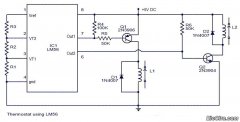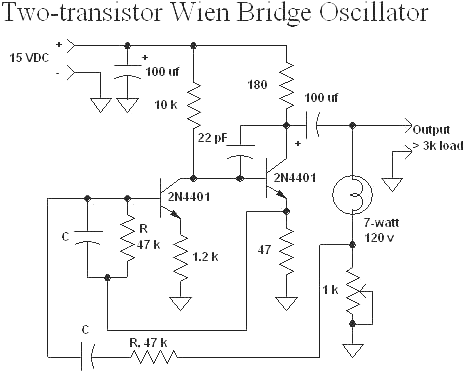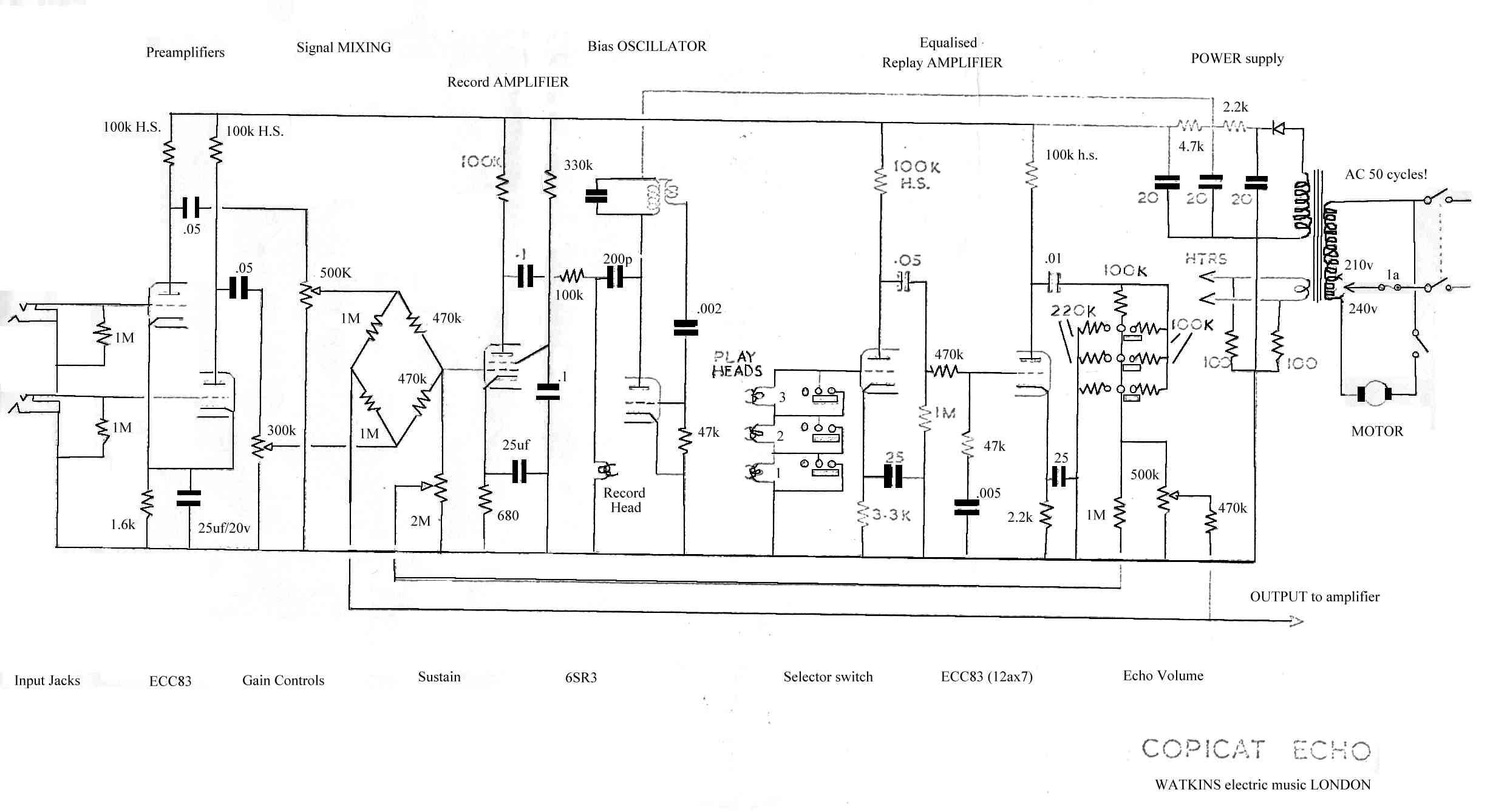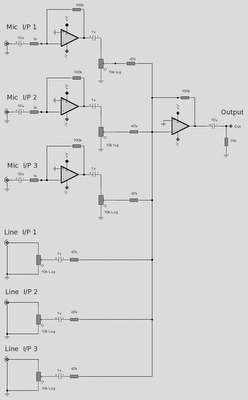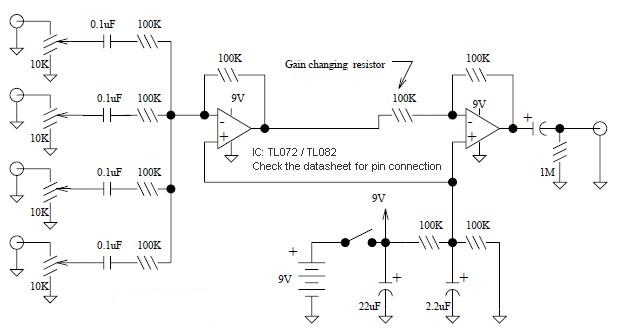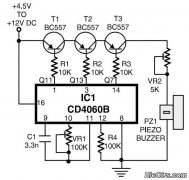
Simple Audio Mixer Circuits
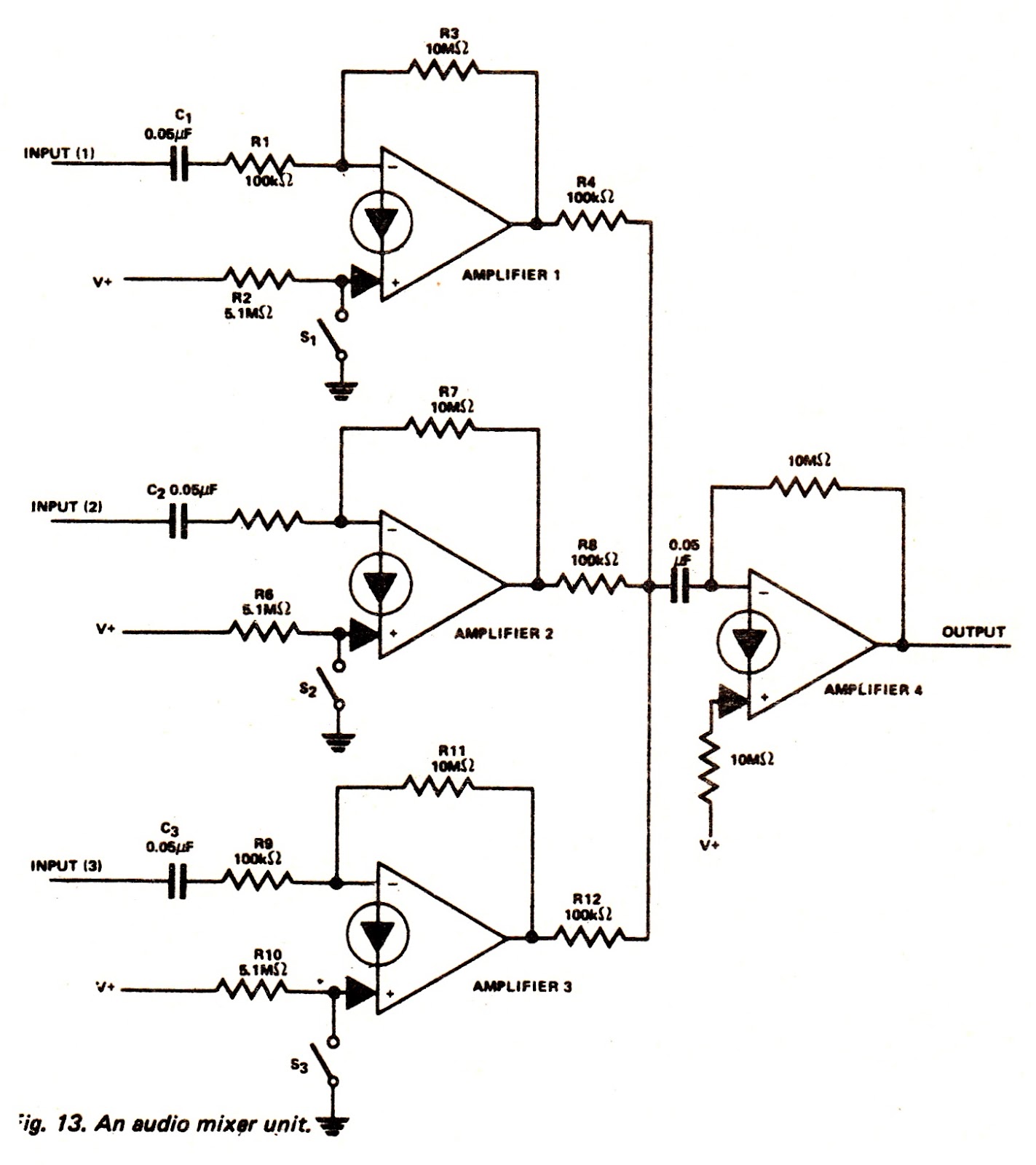
The amplifiers of an LM3900N device can be utilized to create an audio mixer unit that allows for the combination of three separate audio signals into a single composite output. The audio mixer circuit provided operates with a single LM3900N device and includes the ability to select any one channel via switches. The currents flowing through resistors R4, R8, and R1 are summed in the input circuit of the fourth amplifier. If switch S1 is open, amplifier 1 will reach saturation due to the current flowing through R2, rendering it inactive. The simple mixer circuit can function with two or three channels, offering excellent input isolation and outstanding frequency response that extends well into the upper range of the audio spectrum. It is suitable for use with one or more instruments in conjunction with a microphone or for special effects, such as mixing an input with pink noise to create a 'surf' sound. The unit provides an 8 dB gain and, given the low-level signals involved, should be housed in an aluminum enclosure. If a mains supply is utilized, standard anti-hum precautions must be observed. The inclusion of scaled slider potentiometers is recommended to facilitate the recreation of effects.
The LM3900N is a quad operational amplifier that is particularly well-suited for audio applications due to its high input impedance and low output distortion. In the described audio mixer circuit, the device is configured to mix multiple audio signals while maintaining signal integrity. The circuit design allows for the summation of audio signals through a network of resistors. The resistors R4, R8, and R1 play a crucial role in determining the mixing ratios of the input signals, ensuring that each channel contributes appropriately to the final output.
The fourth amplifier in the configuration serves as the summing amplifier, where the mixed audio signals converge. The design also incorporates switches to select which audio channel is active at any given time. This feature enhances flexibility, allowing the user to isolate specific audio sources as needed. The saturation behavior of amplifier 1, when switch S1 is open, indicates that careful attention must be paid to the configuration of the input signals to avoid unwanted distortion.
The circuit's performance is characterized by its exceptional frequency response, which is vital for high-fidelity audio applications. It can accommodate a range of audio inputs, including instruments and microphones, making it versatile for various audio mixing scenarios. The ability to mix with pink noise introduces creative possibilities for sound design, enabling effects that mimic natural acoustic environments.
To ensure optimal performance, the circuit should be enclosed in an aluminum box, which provides shielding from electromagnetic interference and enhances durability. When powered by a mains supply, implementing anti-hum measures, such as proper grounding and the use of shielded cables, is essential to prevent noise from affecting the audio quality. The recommendation to use scaled slider potentiometers allows for precise control over the mixing levels, enabling users to replicate specific sound effects consistently. This mixer circuit exemplifies a practical application of the LM3900N, showcasing its capabilities in audio signal processing.The amplifiers of a LM3900N device can be conveniently used to make a mixer unit for audio purposes; the unit enables three separate audio signals to be mixed together to produce a composite output. The audio mixer circuit shown provides this facility using only a single LM39OON device and also enables any one channel to be selected by switches.
T he currents passing through the resistors R4, R8 and R, are summed in the input circuit of the fourth amplifier. lf S; is open, amplifier 1 will be driven to saturation by the current passing through R2. lt will therefore be inactive. Th below shown simple mixer circuit will work with two or three channels, providing excellent input isolation and exceptional frequency response, extending well over the top end of the audio spectrum.
lt is usable by one or more instruments plus microphone, or with special effects, such as mixing en input with pink noise, to give `surf`. The unit will give 8db gain, and since low-level signals are involved, should be housed in an aluminum box.
lf a mains supply is used, the usual anti-hum precautions must be taken. lt is useful to use scaled slider potentiometers, so that effects may be recreated. 🔗 External reference
The LM3900N is a quad operational amplifier that is particularly well-suited for audio applications due to its high input impedance and low output distortion. In the described audio mixer circuit, the device is configured to mix multiple audio signals while maintaining signal integrity. The circuit design allows for the summation of audio signals through a network of resistors. The resistors R4, R8, and R1 play a crucial role in determining the mixing ratios of the input signals, ensuring that each channel contributes appropriately to the final output.
The fourth amplifier in the configuration serves as the summing amplifier, where the mixed audio signals converge. The design also incorporates switches to select which audio channel is active at any given time. This feature enhances flexibility, allowing the user to isolate specific audio sources as needed. The saturation behavior of amplifier 1, when switch S1 is open, indicates that careful attention must be paid to the configuration of the input signals to avoid unwanted distortion.
The circuit's performance is characterized by its exceptional frequency response, which is vital for high-fidelity audio applications. It can accommodate a range of audio inputs, including instruments and microphones, making it versatile for various audio mixing scenarios. The ability to mix with pink noise introduces creative possibilities for sound design, enabling effects that mimic natural acoustic environments.
To ensure optimal performance, the circuit should be enclosed in an aluminum box, which provides shielding from electromagnetic interference and enhances durability. When powered by a mains supply, implementing anti-hum measures, such as proper grounding and the use of shielded cables, is essential to prevent noise from affecting the audio quality. The recommendation to use scaled slider potentiometers allows for precise control over the mixing levels, enabling users to replicate specific sound effects consistently. This mixer circuit exemplifies a practical application of the LM3900N, showcasing its capabilities in audio signal processing.The amplifiers of a LM3900N device can be conveniently used to make a mixer unit for audio purposes; the unit enables three separate audio signals to be mixed together to produce a composite output. The audio mixer circuit shown provides this facility using only a single LM39OON device and also enables any one channel to be selected by switches.
T he currents passing through the resistors R4, R8 and R, are summed in the input circuit of the fourth amplifier. lf S; is open, amplifier 1 will be driven to saturation by the current passing through R2. lt will therefore be inactive. Th below shown simple mixer circuit will work with two or three channels, providing excellent input isolation and exceptional frequency response, extending well over the top end of the audio spectrum.
lt is usable by one or more instruments plus microphone, or with special effects, such as mixing en input with pink noise, to give `surf`. The unit will give 8db gain, and since low-level signals are involved, should be housed in an aluminum box.
lf a mains supply is used, the usual anti-hum precautions must be taken. lt is useful to use scaled slider potentiometers, so that effects may be recreated. 🔗 External reference
